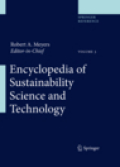
Sustainability in environmental usage refers to the potential longevity of vital human ecological support systems, such as the planet's climate system, systems of agriculture, industry, forestry, fisheries and the ocean, and fresh water, together with the impact of human communities, transportation systems, and the built environment in general on these natural services. Although definitions of 'sustainable development' are often stated without reference to the number of people to be supported and at what standard of living, it is clear that we face something like a 50% increase in food demand as early as 2030, while global energy and materials use is expected to grow by 300% over this period. At the same time, the proportion of the population that lives in an urban environment will rise from about 47% to 60%. Up until now, economic development,growth, and sustainability strategies such as the 'green revolution' were heavily dependent on large inputs of fossil fuels. In addition, about 70% of available freshwater is used by agriculture. Many of these approaches no longer appear sustainable as many natural resources, including petroleum, are poised to become scarce relative to population. Sustainability science and technology is not a discipline, but is the grand challenge of our time. Top-down approaches to controlling population growth, maintaining biodiversity, modeling large-scale systems, etc. certainly do exist, and perspectives on a number of these issues can be found in a complementary work, Springer's 'Encyclopedia of Complexity and Systems Science.' However, science and technology and the resultinginnovation economy is also a bottom-up affair involving myriad individuals and research teams in publicly funded scientific laboratories and private corporations. This process of innovation is essentially unpredictable resulting in agreat range of promising.
- ISBN: 978-0-387-89469-0
- Editorial: Springer
- Encuadernacion: Cartoné
- Fecha Publicación: 15/06/2012
- Nº Volúmenes: 1
- Idioma: Inglés
